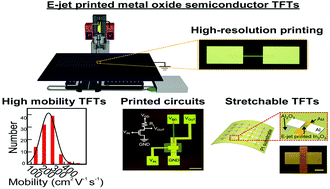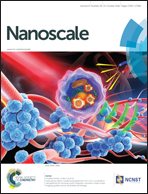High-resolution electrohydrodynamic inkjet printing of stretchable metal oxide semiconductor transistors with high performance†
Abstract
As demands for high pixel densities and wearable forms of displays increase, high-resolution printing technologies to achieve high performance transistors beyond current amorphous silicon levels and to allow low-temperature solution processability for plastic substrates have been explored as key processes in emerging flexible electronics. This study describes electrohydrodynamic inkjet (e-jet) technology for direct printing of oxide semiconductor thin film transistors (TFTs) with high resolution (minimum line width: 2 μm) and superb performance, including high mobility (∼230 cm2 V−1 s−1). Logic operations of the amplifier circuits composed of these e-jet-printed metal oxide semiconductor (MOS) TFTs demonstrate their high performance. Printed In2O TFTs with e-jet printing-assisted high-resolution S/D electrodes were prepared, and the direct printing of passivation layers on these channels enhanced their gate-bias stabilities significantly. Moreover, low process temperatures (<250 °C) enable the use of thin plastic substrates; highly flexible and stretchable TFT arrays have been demonstrated, suggesting promise for next-generation printed electronics.



 Please wait while we load your content...
Please wait while we load your content...